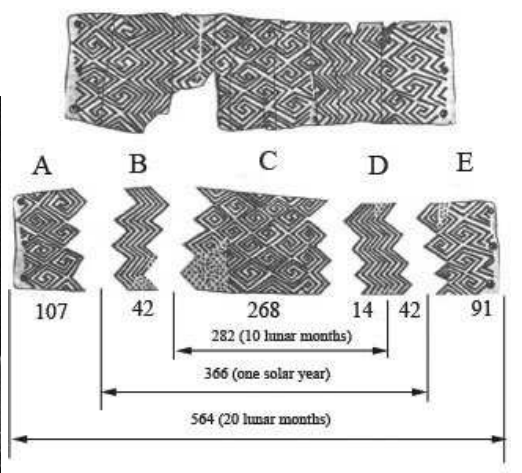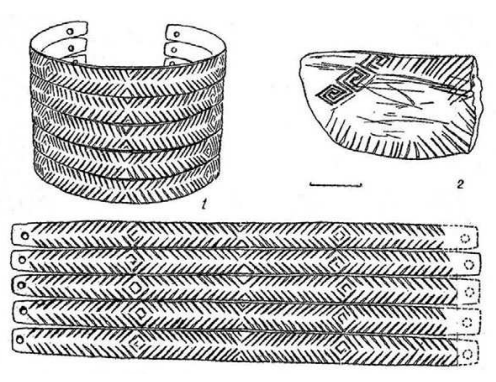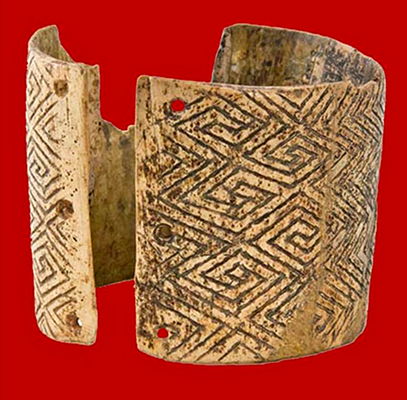Iryna Vavilova and Tetyna Artemenko from the Main Astronomical Observatory of the NAS of Ukraine in their 2009 article ‘The ancient cultural framework of Astronomy in Ukraine’ wrote the following: “The remains of another settlement dated to the Upper Paleolithic on the right bank of the Desna River near Mezin, Chernigiv region were found casually when digging a hole for a cellar in 1908. The announcement about this discovery was reported immediately by F.K. Volkov at the XIVth Archaeological Meeting in Chernigiv in August 1908. At present, due to the archaeological expeditions of 1930, 1932, 1954-1956, the Mezin Paleolithic settlement is the most studied one in Ukraine. Among the unique finds later on named as the Mezin Art were the mammoth ivory phallic figurines and birds as well as bones painted with red ochre; female statuette carved with double pubic triangle and engraved chevrons; mammoth ivory needle with the eye, engraved with chevrons (see, for example Shovkoplyas 1965, for the first detailed prospecting). The most remarkable Mezin art objects are two elaborately created and lavishly ornamented bracelets carved out of mammoth ivory. These Paleolithic bracelets dated from about 20,000 BCE as Okladnikov wrote are “the authentic masterpieces of bone-carver art, causing a surprise due to that they are executed by the stone instruments, without a lathe, drills, and chisels. A bone material for these decorations had an exceptional aesthetic value. At the same time, neither magic, including magic of numbers, nor cult of ancestors had, on the essence, a direct relation to the rhythmic alternation and to the symmetric position of decorative pattern” (Okladnikov 1967). They have a magnificent design which can be found to this day in the embroidery of Ukrainian costumes. This pattern predates and is similar to the famous Greek ‘meander’ pattern.”
The first of these bracelets (title image), unearthed in 1912, has the “appearance of the wide and thin bent plate, the external surface of which is covered by the complicated geometrical decorative meander and fir-tree pattern. On the ends of the bangle are three large openings for lacing. The width of the plate is 5.3 cm” (Abramova 1962, Table XXXIV). It may be considered a coincidence but this artifact may represent a rare example of the most ancient lunar-solar calendar. Binning this pattern, one can find that “two reiterating meander groups are divided twice by zones of zigzags. Each of the zigzags consists of 7 lines. We may select surely 5 zones of pattern: A, C, and E in the center and at the edges of meander zone; B and D zones” (Frolov 1971). This ornament, covered by parallel strokes and parted on the areas of zigzags, consists of a total of 564 lines (20 lunar months). It is interesting that the number of lines in the central area and in zigzags is equal to 366 which almost corresponds to one solar year. Another important conclusion is that this possible form of the ancient calendar is based exactly on the period of 10 lunar months or 280 days”.

The second Mezin bracelet, which was discovered in 1956, is a very unique Paleolithic find too. It consists of five joined rings made from the mammoth tusk (length about 19 cm, width about 1 cm) and is decorated with ornamentation. The external surfaces of its plates are covered by a fretwork geometrical pattern: rows of fir trees are directed in the opposite direction and form a clear meander pattern at the junctions from the recurring groups of parallel strokes, which are directed at an angle to the edge of the bracelet (Abramova 1962; Shovkoplyas 1965). This ornament can be interpreted as a primitive calendar with fertility and crop symbols. It is known that the meander pattern is considered to represent a symbol of fertility. Most groups consist of 14 strokes; there are groups of 13 and 15 strokes. The direction of strokes in two neighboring groups is 90◦. Each part of the bracelet having 27-29 strokes could be interpreted as a calendar of the lunar months. The changes in the direction of strokes at 90◦ may reflect that a lunar disc is increasing during the first part of the month and decreasing in the second part of the month. In other words, the essence of interpretation is as follows (Fig. 4b). Groups from 14(±1) strokes, which change their direction periodically exactly after this number, could correspond with the same visibility occurrence, in this case with the increasing lunar disc before the full Moon, and with the decreasing lunar disc before the new Moon during the 28-29 days of the lunar month. Following this rhythm, two lunar months are ‘written’ at the edges of plates. It results that a full number of days in 10 lunar months could be ‘written’ on all 5 plates of the bracelet (Frolov 1971). It is important to emphasize that the base of these possible palaeo-astronomical calendars (10 lunar months or 280 days) coincides with a period of pregnancy for women. Many scientists consider that such a period related to the Moon could be chosen by primitive people as the obvious unit of measurement of time duration for long-term observational events. Incidentally, Shovkoplyas (1965), studying a form of ornaments on both Mezin bracelets in detail, noted that they have specifically female attributes.”

More about other incredible archaeological discoveries made in Ukraine are in the “Cradle of Civilizations” book.










